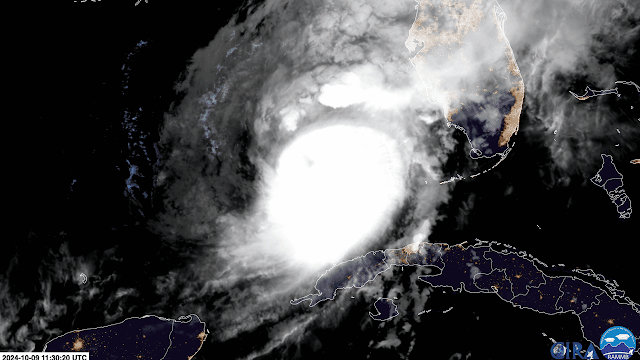This morning, Milton is a formidable Category 4 hurricane, moving steadily towards Florida.
In the satellite loop below, you can see Milton's outer rainbands, marked by puffy clouds, advancing onto the Florida coast and over western Cuba.
Milton's path continues to change, and the final adjustments will decide where the worst impact of the storm will be felt.
Yesterday, Milton continued to surprise forecasters by moving significantly farther south than anticipated and not beginning its northeast shift. Each hour that Milton stayed on its current path pushed its predicted trajectory further south along Florida's west-central Gulf Coast.
On Tuesday morning at 8 a.m. ET, the forecast indicated that Milton would make landfall in the southern part of the Tampa Bay area by late Wednesday. However, the latest predictions now place the hurricane's landfall 20 to 25 miles further south, near the Sarasota area.
This shift could significantly alter the impact for the Tampa Bay region, distinguishing between a catastrophic worst-case scenario and a chance to mitigate disaster. As a result of the updated track, the storm surge forecast for Tampa Bay has been adjusted slightly downwards from a potential 15 feet to up to 12 feet.
Overnight, Milton began to turn northeast, but minor track variations remain possible up to landfall, and they could have serious implications. Factors such as interaction with land and atmospheric conditions can cause a hurricane to unpredictably wobble or change direction. Thus, all areas within the cone need to prepare for the possibility of landfall.
The National Hurricane Center emphasized on Wednesday morning the importance of not solely concentrating on the precise landfall point, noting that the average error at a 24-hour mark is approximately 40 miles.
Residents opting to remain in Milton's danger zone are getting ready to ride out the storm.
Destroyed buildings are seen after Hurricane Ian caused widespread destruction in Sanibel Island, Florida, on October 1, 2022.
Officials are cautioning that time is running short for evacuations ahead of Hurricane Milton's arrival in Florida, yet some residents have chosen to remain. Bridgit Stone-Budd, a Sanibel Island resident, experienced the devastation of Hurricane Ian firsthand.
“I think the most crucial aspect is knowing that we won’t be able to return,” Stone-Budd told CNN’s John Berman on Wednesday, explaining her choice to stay. “That’s the primary reason.”
The city of Sanibel has issued an evacuation order, and those who opt to remain are now under a 24-hour curfew. Stone-Budd lives in a stilted home that has withstood flooding in past hurricanes, but she recognizes that this does not guarantee safety.
“I feel secure in our elevated home, but the thought of losing a pylon and the house becoming unstable is what frightens me the most,” she said.







No comments:
Post a Comment